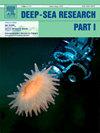卡斯卡迪亚边缘烃类渗漏大型动物群落结构因素
IF 2.1
3区 地球科学
Q2 OCEANOGRAPHY
Deep-Sea Research Part I-Oceanographic Research Papers
Pub Date : 2025-09-04
DOI:10.1016/j.dsr.2025.104590
引用次数: 0
摘要
在烃类化学合成的推动下,冷渗漏支持着独特的底栖生物群落,这些底栖生物群落在受当地地球化学影响的小空间尺度上存在差异。我们研究了沿卡斯卡迪亚边缘天然气水合物稳定边缘的冷渗漏中大型动物的群落结构和功能-一个可能随着海底温度变化而波动的动态环境。这些群落被评估与其沉积物环境的关系,为这些以前未调查的渗漏提供基线数据,并破译构成它们的最重要变量。具体的环境驱动因素包括沉积物有机碳、总氮、碳氮比、稳定同位素(δ13C和δ15N)、氧化还原电位、粒度和孔隙流体化学。不同地点的大型动物群落组成不同,分为12个不同的群落。在小的空间尺度上,几个同地的核心群落分别聚集在一起,表明这些群落具有高度的异质性。粘土和砂土含量、碳氮比、δ15N值、有机碳含量和深度是影响大型动物群落的重要因素。功能性状组成受土层深度、δ15N值、碳氮比和含沙量等因素的影响。我们的研究结果表明,在小尺度和大尺度梯度上,类似的环境变量构成了大型动物群落的组成和功能,有助于我们理解形成渗漏型大型动物群落的地方和区域因素的异质性。这是在这些新近发现的渗漏中首次对大型动物进行调查,并为未来的比较提供了水合物稳定带的基线数据,提高了我们对渗漏大型动物生态学大范围趋势的认识。本文章由计算机程序翻译,如有差异,请以英文原文为准。
Factors structuring macrofaunal communities of hydrocarbon seeps along the Cascadia margin
Cold seeps, fueled by hydrocarbon-based chemosynthesis, support unique benthic communities that can vary across small spatial scales influenced by local geochemistry. We examined the community structure and function of macrofauna in cold seeps along the Cascadia margin on the edge of gas hydrate stability—a dynamic environment that may fluctuate as seafloor temperatures change. These communities were assessed in relation to their sediment environment to provide baseline data for these previously uninvestigated seeps and decipher the most significant variables structuring them. Specific environmental drivers investigated include sediment organic carbon, total nitrogen, C:N ratios, stable isotopes (δ13C and δ15N), redox potential, grain size, and porefluid chemistry. Macrofaunal community composition varied across locations separating into twelve distinct clusters. Several co-located cores clustered separately, indicating high heterogeneity in these communities at small spatial scales. Significant drivers of macrofauna communities included clay and sand content, C:N, δ15N values, organic carbon content, and depth. Functional trait composition was influenced by similar drivers, including depth, δ15N values, C:N, and sand content. Our results indicate similar environmental variables structure macrofaunal community composition and function across small- and large-scale gradients, contributing to our understanding of heterogeneity in local and regional factors that shape seep macrofaunal communities. This is the first investigation of macrofauna at these recently discovered seeps and provides baseline data on the hydrate stability zone for future comparisons, advancing our knowledge of broad-scale trends in seep macrofauna ecology.
求助全文
通过发布文献求助,成功后即可免费获取论文全文。
去求助
来源期刊
CiteScore
4.60
自引率
4.20%
发文量
144
审稿时长
18.3 weeks
期刊介绍:
Deep-Sea Research Part I: Oceanographic Research Papers is devoted to the publication of the results of original scientific research, including theoretical work of evident oceanographic applicability; and the solution of instrumental or methodological problems with evidence of successful use. The journal is distinguished by its interdisciplinary nature and its breadth, covering the geological, physical, chemical and biological aspects of the ocean and its boundaries with the sea floor and the atmosphere. In addition to regular "Research Papers" and "Instruments and Methods" papers, briefer communications may be published as "Notes". Supplemental matter, such as extensive data tables or graphs and multimedia content, may be published as electronic appendices.

 求助内容:
求助内容: 应助结果提醒方式:
应助结果提醒方式:


